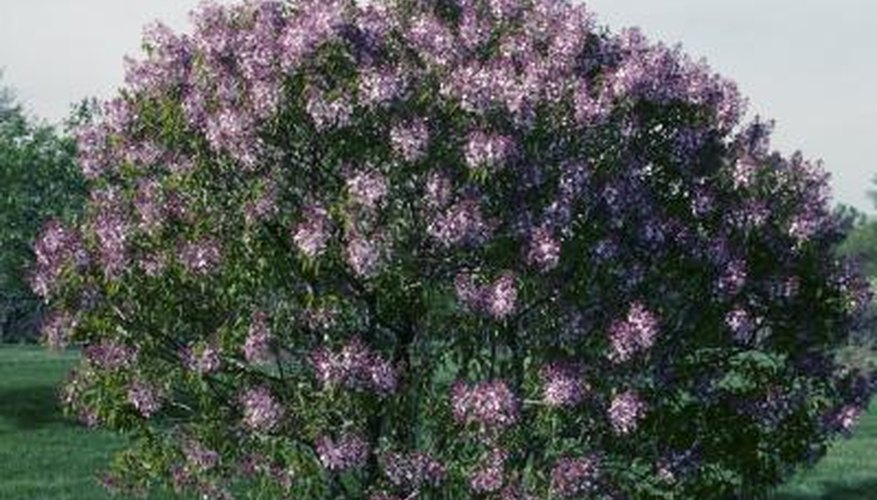In late spring, a Persian lilac shrub will bear a profusion of small, 2-inch-long fragrant white to rich lavender blossom clusters on its branch tips. A compact, bushy deciduous shrub, Persian lilac (Syringa x persica) is a horticultural hybrid, created by crossing cutleaf lilac (Syringa x laciniata) with the Afghan lilac (Syringa afghanica). This fast-growing shrub requires a cold winter dormancy to bloom well; it thrives in U.S. Department of Agriculture Plant Hardiness Zones 3 through 7, particularly in regions where summers aren't oppressively hot.
Growth Rate
Persian lilac is among the fastest-growing lilacs, adding between 12 and 18 inches of branch length each year. Healthy, disease-free plants grow at a faster rate than those stressed by infertile or dry soils. Insects such as borers, scales and caterpillars can reduce growth by destroying foliage and young twigs. Fungal diseases, especially powdery mildew and verticillium wilt, can reduce photosynthesis in leaves or kill foliage, slowly the growth rate as well.
- Persian lilac is among the fastest-growing lilacs, adding between 12 and 18 inches of branch length each year.
- Fungal diseases, especially powdery mildew and verticillium wilt, can reduce photosynthesis in leaves or kill foliage, slowly the growth rate as well.
Size and Habit
Within five years, a Persian lilac shrub reaches its mature size of 5 to 8 feet tall and 5 to 10 feet wide. The silhouette of the plant is a rounded dome with many vertical branches, sometimes described as multiple thin trunks. Persian lilac may be kept a bit small when mature by limited pruning of branch tips immediately after flowers wane. This species of lilac does not respond well to harsh, rejuvenation pruning, unlike the common lilac (Syringa vulgaris).
- Within five years, a Persian lilac shrub reaches its mature size of 5 to 8 feet tall and 5 to 10 feet wide.
- Persian lilac may be kept a bit small when mature by limited pruning of branch tips immediately after flowers wane.
Growing Conditions
In ideal growing conditions, expect closer to 18 inches of growth annually on Persian lilac shrubs; 12 inches occurs when soils are not optimal. Plant Persian lilac in a fertile, crumbly soil that is moist but always well-drained. It tolerates slightly acidic soil, but is best in neutral to slightly alkaline soils, pH 7.0 to 8.0. Full sun is best, as it promotes flowering as well as even growth and development across the entire plant. Too much shade increases chances for fungal diseases from wet foliage, and may cause uneven growth. Good air circulation around Persian lilacs also diminishes risks of leaf fungal problems.
- In ideal growing conditions, expect closer to 18 inches of growth annually on Persian lilac shrubs; 12 inches occurs when soils are not optimal.
Tips
Rather than worry about fertilising Persian lilac, maintain a 3-inch-deep organic mulch layer over the soil all around the shrub. The mulch supplies nutrients to the already fertile garden soil as it decomposes, deters weeds and shades the soil in the summer sun. To maintain the overall plant size, prune back branches by 12 to 18 inches each year after the flowering show ends. Make the pruning cuts 1/2 inch above a lower branch junction, pair of leaves or pair of dormant buds on the node scars on barren branches. Clip off any unwanted basal suckers at ground level to prevent the shrub from adding new trunks and becoming wider.
- Rather than worry about fertilising Persian lilac, maintain a 3-inch-deep organic mulch layer over the soil all around the shrub.
- Clip off any unwanted basal suckers at ground level to prevent the shrub from adding new trunks and becoming wider.
